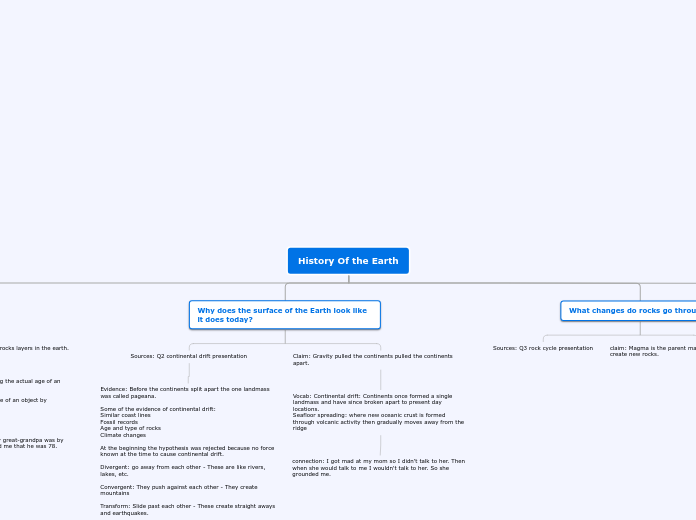History Of the Earth
How do we determine the age of the Earth?
Sources: Determine age Q1 presentation
Evidence: An undeformed sedimentary rock layer is older than the layers above it and younger than the layers below it.
Absolute dating is determining the actual age of an object. You can use this by asking a person how old they are.
Relative dating is determining the age of an object by comparing its age to another object. Which you can use for trying to figure out how old your parents friends are.
The earth was formed from the big bang.
Claim: We determine age by the rocks layers in the earth.
Vocab: Absolute dating: Determining the actual age of an object.
Relative dating: Determining the age of an object by comparing it to another object.
Connection: I found out how old my great-grandpa was by asking my mom. Then my mom told me that he was 78.
Why does the surface of the Earth look like it does today?
Sources: Q2 continental drift presentation
Evidence: Before the continents split apart the one landmass was called pageana.
Some of the evidence of continental drift:
Similar coast lines
Fossil records
Age and type of rocks
Climate changes
At the beginning the hypothesis was rejected because no force known at the time to cause continental drift.
Divergent: go away from each other - These are like rivers, lakes, etc.
Convergent: They push against each other - They create mountains
Transform: Slide past each other - These create straight aways and earthquakes.
Claim: Gravity pulled the continents pulled the continents apart.
Vocab: Continental drift: Continents once formed a single landmass and have since broken apart to present day locations.
Seafloor spreading: where new oceanic crust is formed through volcanic activity then gradually moves away from the ridge
connection: I got mad at my mom so I didn't talk to her. Then when she would talk to me I wouldn't talk to her. So she grounded me.
What changes do rocks go through?
Sources: Q3 rock cycle presentation
claim: Magma is the parent material. They use each other to create new rocks.
